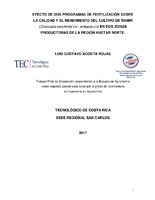Efecto de dos programas de fertilización sobre la calidad y el rendimiento del cultivo de ñampi (Colocasia esculenta var. antiquorum) en dos zonas productoras de la Región Huetar Norte.
Abstract
The research was carried out in Agua Azul farm in La Fortuna de San Carlos, Alajuela, Costa Rica and La Vega farm in La Vega, San Carlos, Alajuela, Costa Rica, where the response on quality and yield of the ñampí was evaluated ( Colocasia esculenta var. Antiquorum) exposed to natural soil fertility and to two fertilization programs. The experiment included three treatments, an absolute control to which no fertilization was performed, a conventional fertilization treatment, consisting of 58 kg / ha of N, 51 kg / ha of P2O5 and 76 kg / ha of K2O, and one Third treatment with a fertilization created from the absorption curve of the crop, which consisted of 81 kg / ha of N, 53 kg / ha of P2O5, 109 kg / ha of K2O and 18 kg / ha of MgO. In both treatments applications were performed at four, twelve and 20 weeks after sowing. A Complete Blocks Design was used and the variables were analyzed using a Variance Analysis and LSD Means test at 90% and 95%. There were significant differences in the average weight of the first-quality corms 98,24 ± 2,7, where the treatment without any fertilization of Agua Azul farm was superior to the treatment without fertilization of the La Vega farm. In addition, for the variable quantity of first (91.5 ± 6.9) and second quality (553.2 ± 9.8), the first yield (1993,7 ± 181,9) and second (4688.1 ± 254.8), the treatment based on the absorption curve in the Agua Azul farm was the one that presented the highest values. The benefit / cost ratio showed that the treatment without any application in first quality corms presented the value (B / C = 1.3) for this ratio, whereas the treatment under fertilization based on the absorption curve in first quality cormels had the lowest value for this ratio (B / C = 0.34 ).
Description
Trabajo Final de Graduación (Licenciatura en Ingeniería en Agronomía). Instituto Tecnológico de Costa Rica, Escuela de Agronomía, 2017.


